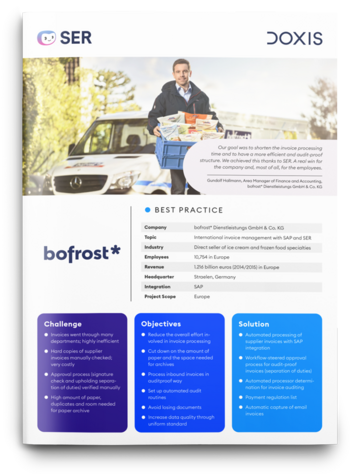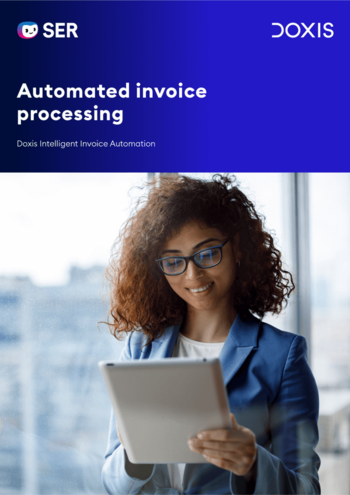SER Blog Information Governance
VAT in the Digital Age (ViDA)
What businesses today should already know
VAT in the Digital Age (ViDA) is modernizing the VAT system in the European Union. The initiative aims to set up a secure electronic VAT system that minimizes the risks of fraud. Basically, it changes the way businesses report and process B2B sales.
So, let's jump into what ViDA is all about and what the VAT reform means for your business.

What does ViDA stand for?
ViDA stands for “VAT in the Digital Age.” It's the EU Commission’s package of measures designed to reform the Value Added Tax Directive (VAT Directive 2006/112/EC). The directive widely standardizes the European VAT system, based on the EU standard CEN 16931, which the European Commission initially developed for public service contracts. But today, it's defining the standards for eInvoicing in Germany.
Background about ViDA
With advances in digitalization over recent years, new business models have developed that the old VAT system directive doesn't cover. At the same time, it's not yet focused on digital processes. The European Commission sees a risk, as the current VAT system “limits the collection and monitoring of VAT.” As a result, it's not currently possible for EU member states to effectively prevent tax fraud.
The European Commission also argues that the current VAT system is outdated and complicates processes for companies. ViDA is intended to change that, with the reforms poised to modernize the VAT system by using state-of-the-art technology to reduce costs and administrative workloads for all those involved.
The EU Commission’s package of measures: These are the objectives
The EU Commission’s package of measures refers to all amendments resulting from the VAT Directive (2006/112/EC), Council Implementing Regulation (EU) no. 282/2011, and Council Regulation (EU) no. 904/2010 on administrative cooperation.
The EU Commission is pursuing three objectives with its package of measures:
-
Modernizing VAT reporting requirements for sales through mandatory digital reporting
-
Updating and clarifying VAT rules to address unequal treatment between platform operators and traditional providers
-
Creating a single VAT registration form by using a standardized template for all member states
1. Mandatory digital reporting
Based on electronic invoicing, ViDA is intended to modernize reporting requirements. For businesses, this means reporting will occur in real time. In order to do this, the reporting system will have to report sales in a structured and standardized electronic format. Thanks to real-time transmission, the time taken to issue invoices for intra-community deliveries and services is also reduced to just a few days after receipt or sending. As a result, individual reports will replace collective reports to the authorities.
The European Commission believes the reform will have the following two major benefits:
-
It will minimize tax fraud and thus result in higher revenues for all member states.
-
At the same time, it will reduce administrative costs for businesses.
The latter is achieved by modernizing reporting requirements and harmonizing national reporting systems: businesses will submit their reports using a standardized template that is binding for all member states.
2. Platform economies
The VAT reform is intended to promote equal treatment of platform economies – multi-sided sales models in which at least three or more user groups are involved, in addition to the online platform. The problem is that platform economies have created a situation in which VAT-registered companies are competing with organizations that provide VAT-exempt services via a platform.
The measures apply mainly to the following:
-
Developing the VAT directive consistently for all member states, in order to avoid double taxation and non-taxation.
-
Requiring platforms to maintain easily accessible documents and information about B2C services, in addition to information on B2B services.
-
Using the deemed supplier/service provider model to solve unequal treatment by requiring platforms to pay VAT, if the private individual is not liable for VAT.
3. VAT registration
Multiple VAT registrations will no longer be necessary thanks to ViDA. A one-time VAT registration at EU level reduces the costs and related workload for businesses. Companies should also be able to centralize their tax matters in an online portal and with a user-defined language.
Recently, OSS (One Stop Shop) and IOSS (Import One Stop Shop) regulations have simplified VAT registrations. For example, since IOSS is a voluntary solution, it only provides limited protection against multiple VAT registrations. The REFIT initiative “VAT in the Digital Age” aims to expand the OSS and IOSS schemes, and reform VAT rules for tax authorities and the private sector with regard to digital technologies.
The current status of ViDA
For the ViDA initiative to come into force, all 27 EU member states have to agree to the legislative proposals. So far, the ECOFIN Council has not reached an agreement. It's expected that the regulations once approved will differ somewhat from the draft law. For example, businesses might not be required to issue electronic invoices for certain cross-border sales until July 1, 2030, rather than January 1, 2028, as proposed.
Currently, the following proposals diverge from the original draft law:
-
Electronic invoicing for certain cross-border sales: Postponed from January 1, 2028 to July 1, 2030.
-
Invoicing for certain cross-border sales: Within ten days instead of the proposed two.
-
Mandatory digital reporting for certain cross-border sales: Within five days instead of the proposed two.
Further drafts are expected before the ViDA initiative is ready for adoption. What is certain, however, is that the new law will change invoicing and tax processes in the B2B sector. Businesses have to ramp up their technology to prepare for these reforms – starting with the electronic invoice or eInvoice.

bofrost*: Automated inbound invoice processing with ECM & SAP
Read all about how bofrost* automates its invoice processing with Doxis, saving time and money along the way.
Read nowHow will this impact the United Kingdom?
As the European Union implements the ViDA initiative, UK businesses that trade with the EU will need to adapt to the EN 16931 standard. While there's no domestic requirement for UK companies to adopt these practices, failing to comply could disrupt trade relations with EU partners.
Key points:
- Compliance requirements: UK businesses must ensure their eInvoicing systems align with the EN 16931 standard to maintain smooth operations with EU entities.
- Technological preparation: Companies should review their current invoicing systems to handle required formats and integrate effectively with other business systems.
- Strategic benefits: Adopting eInvoicing aligns with broader digital transformation goals, such as reducing manual errors, enhancing data security, and improving operational efficiency.
- Timelines for compliance: Various EU countries are implementing mandatory eInvoicing in phases, with some requiring compliance as early as 2024.
And if you're in a position where you can help your UK clients or service providers gear up for these new eInvoicing standards, you need to make sure they're aware of your needs and have time to get their processes in place. The best way to do this is by email from your finance team containing elements such as:
-
Details of EN 16931: Explain the core elements of the EN 16931 standard, highlighting the mandatory adoption of electronic invoicing for transactions within the EU.
-
Implementation timeline: Provide a timeline for when the eInvoicing standards will come into effect in your business, and any important dates by which changes should be implemented by the UK partners.
-
Technical specifications: Describe the required formats you need (like UBL or UN/CEFACT CII) and any technical specifications or systems that UK partners will need to adopt or interface with.
-
Compliance expectations: Outline what compliance will look like, including data models, syntax bindings and compliance levels as specified by the EN 16931 standard.
-
Action required: Clearly state what actions UK partners need to take next, such as reviewing their current systems, scheduling a consultation, or attending a webinar for more information.

Doxis Intelligent Invoice Automation
How to automate inbound invoice workflows, expedite invoice processing and save costs — with Doxis Intelligent Invoice Automation.
Get the free guideSummary: Set up processes today for eInvoicing and ViDA
Invoicing processes will change fundamentally for businesses nationally and across the EU in the coming years. Before the ViDA reform of VAT, eInvoicing will be mandatory for all companies in Germany from 2025, though this isn't necessarily the same for other EU member states, so we recommend checking your government website to stay in the loop. But generally, in order to prepare today for the changes of tomorrow, enterprises need to start reviewing their technology-driven processes or – if none exist yet – set them up for the first time. You absolutely need the following: an ERP system, a DMS and invoicing software that complies with ViDA and eInvoicing requirements.
FAQs about technical documentation
The latest digitization trends, laws and guidelines, and helpful tips straight to your inbox: Subscribe to our newsletter.
How can we help you?
+49 (0) 30 498582-0Your message has reached us!
We appreciate your interest and will get back to you shortly.




